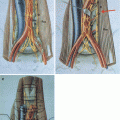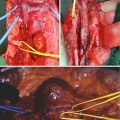Treatment option
USA (N:261)a (%)
Europe (N:969) (%)
RAD
Chemotherapy
Surveillance
Several options
62b
3b
21b
19
21
18
42
Importantly, experience with active surveillance has proven that about 80 % of patients with seminoma stage 1 are rendered tumor-free by orchiectomy alone. Thus, any adjuvant treatment strategy must be considered critically [14]. While adjuvant treatment strategies have been compared to each other by several controlled trials [4, 6], no formal randomized trial has been performed comparing surveillance with adjuvant therapy in seminoma patients stage 1. Nevertheless, today’s principal question is whether surveillance should be offered to all patients with seminoma CS1 or only to those with an elevated risk of recurrence based on recognized risk factors.
In the pooled analysis by Warde et al. [33], primary tumor size >4 cm and rete testis invasion have been associated with subsequent recurrence in patients following the surveillance strategy. The Spanish Germ Cell Cancer Group has developed a risk-adapted treatment policy based on these risk factors [34]. In the largest study on surveillance comprising of 1,954 patients with seminoma stage 1, the Danish group recently confirmed tumor size to be associated with risk of relapse [14]. In addition, vascular invasion and epididymal invasion were found to predispose to progression if patients are put on surveillance. Although these results were generated in a (nonrandomized) single-arm study, the results appear to be quite mature because of the huge sample size of the study and because of the consistency with previous results.
Accordingly, a majority of European experts favor the use of adjuvant carboplatin in patients with one or two risk factors [35]. As many as 48 % of the experts attending the Third European Consensus Conference in November 2011 selected surveillance as the treatment of choice for patients with low-risk seminoma stage 1 but preferred adjuvant therapy for those with two high-risk features. Novel molecular biomarkers that have been proposed recently may help indicate microscopically metastasized disease in the near future. But, clearly, these novel tools need confirmation in further studies [36, 37].
In summary, two therapeutic strategies exist for patients with stage 1 seminoma: active surveillance or adjuvant therapy with chemotherapy. Radiotherapy is no longer considered a part of routine treatment. It may however still be considered in the very few selected patients for whom surveillance appears inappropriate and chemotherapy is contraindicated. Any post-orchiectomy therapy if applied to unselected patients represents “overtreatment” in 80 % of all patients. Adjuvant chemotherapy with carboplatin appears justified in the cases with the currently known risk factors, though unequivocal evidence for the usefulness of these factors is still lacking.
2.2 Stage IIA/B
Radiotherapy is still a valid option in patients with limited spread to the retroperitoneal lymph nodes [15]. At the Third European Consensus Conference, approximately 70 % of the experts viewed three cycles of BEP or four cycles of EP as an equally effective or even preferred option in patients with CSIIA (lymph node size <2 cm). This percentage increased to 94 % in patients with stage CSIIB (lymph node size 2–5 cm) [35]. If radiotherapy is applied, the target field should comprise the para-aortic and the ipsilateral pelvic lymph nodes, with the target dose being 30 Gy and additional 10 Gy to the involved lymph node area. The relapse rate is approximately 10 %, and most recurrences are located above the diaphragm [38]. In a series published after 2001, cause-specific survival was reported to be between 97.5 and 100 % [5]. On the other hand, treatment with cisplatin-based chemotherapy considerably reduces the relapse rate in patients with early metastatic seminoma: according to the Swedish-Norwegian Testicular Cancer Group, no relapse was observed after three cycles of BEP in 73 patients with CSIIA after 5 years of follow-up [13].
Neither was there a relapse among 26 Spanish patients with CSIIA treated with BEP chemotherapy [39]. In Kollmansberger et al.’s experience, only 1 of 65 patients relapsed whose initial treatment consisted of chemotherapy due to early CSII [40].
A third alternative, the combination of one to two cycles of carboplatin prior to radiotherapy, has been shown to lower the risk of relapse in seminoma stage II with limited extent [41]. Recently, the Swiss Testicular Cancer Study Group initiated a study for stage IIA/B disease combining one course of carboplatin and node radiation.
In summary, three cycles of BEP chemotherapy or four cycles of EP should be the routine treatment for early metastatic seminoma. Radiotherapy, eventually combined with carboplatin, should represent the exception in case of expected intolerability of BEP chemotherapy.
2.3 Conclusion
Radiotherapy is no longer a part of the routine treatment of stage 1 seminoma. In patients with early stage II, radiotherapy may exceptionally be used after thorough counseling about the particular pros and cons of this treatment modality when compared to chemotherapy.
References
1.
Barringer BS, Stewart FW, Spies JW. Testicular neoplasms: the relation between the pathologic histology, clinical course and reaction to irradiation in testicular neoplasms. Ann Surg. 1930;91:115–22.CrossRefPubMedCentralPubMed
2.
Fosså SD, Horwich A, Russell JM, et al. Optimal planning target volume for stage I testicular seminoma: A Medical Research Council randomized trial. Medical Research Council Testicular Tumor Working Group. J Clin Oncol. 1999;17:1146.PubMed
3.
Jones WG, Fosså SD, Mead GM, et al. Randomized trial of 30 versus 20 Gy in the adjuvant treatment of stage I testicular seminoma: a report on Medical Research Council Trial TE18, European Organisation for the Research and Treatment of Cancer Trial 30942 (ISRCTN18525328). J Clin Oncol. 2005;23:1200–8.CrossRefPubMed
4.
5.
Classen JH, Schmidberger C, Meisner C, et al. Para-aortic irradiation for stage I testicular seminoma: results of a prospective study in 675 patients. A trial of the German testicular cancer study group (GTCSG). Br J Cancer. 2004;90:2305–11.PubMedCentralPubMed
Stay updated, free articles. Join our Telegram channel

Full access? Get Clinical Tree






